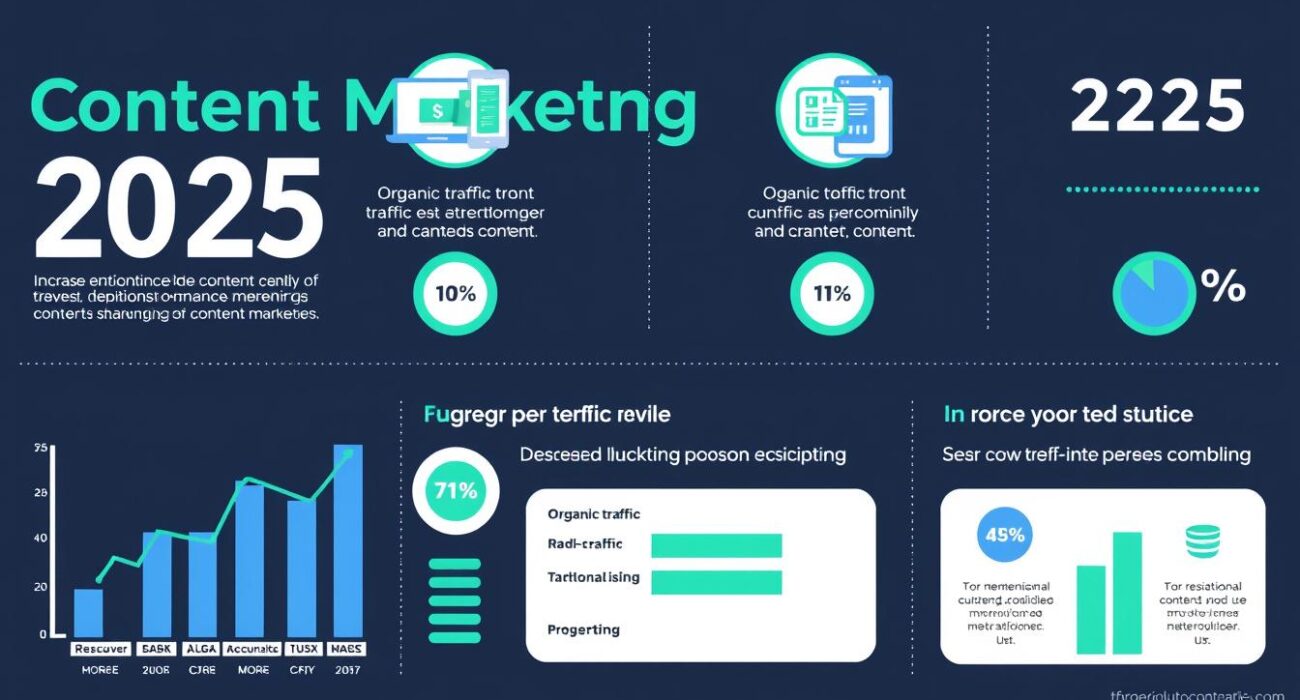In this comprehensive guide, we’ll explore innovative content marketing ideas specifically designed to drive organic traffic in 2025. Whether you’re a seasoned marketer looking to refresh your strategy or a business owner trying to boost your online presence, these actionable tactics will help you cut through the digital noise and connect with your target audience more effectively.
Why Content Marketing Matters More Than Ever in 2025
Before diving into specific strategies, let’s understand why content marketing continues to be crucial for driving organic traffic in 2025:
The evolving landscape of content marketing in 2025 shows a clear shift toward quality over quantity
Search Engines Prioritize Quality Content
Google and other search engines continue to refine their algorithms to reward content that genuinely helps users. In 2025, this means creating comprehensive, accurate, and engaging content that addresses specific user needs. The days of keyword stuffing and thin content are long gone. Today’s search engine optimization requires a deep understanding of search intent and the ability to deliver exceptional value.
Content Builds Trust and Authority
In an era of information overload and growing skepticism, establishing your brand as a trusted authority is more valuable than ever. Consistent, high-quality content marketing helps position your business as a reliable source of information, building credibility with both search engines and potential customers.
Organic Traffic Provides Sustainable Results
While paid advertising has its place, organic traffic driven by content marketing offers long-term benefits without ongoing costs. A well-crafted piece of content can continue to attract visitors for years, providing an excellent return on investment compared to paid campaigns that stop delivering the moment you stop spending.
Content Fuels Multiple Marketing Channels
Great content doesn’t just drive search traffic—it powers your entire digital marketing ecosystem. From social media and email marketing to lead nurturing and customer retention, content serves as the foundation for meaningful connections across multiple touchpoints in the customer journey.
Content Marketing Challenges in 2025
Despite its effectiveness, content marketing in 2025 comes with unique challenges that marketers must overcome:

Content marketers face increasing challenges from content saturation and AI-generated competition
Content Saturation
The sheer volume of content being published daily makes it harder to stand out. Nearly every topic has been covered extensively, requiring marketers to find fresh angles or deliver exceptional quality to capture attention.
AI-Generated Content Competition
With AI tools becoming more sophisticated, the market is seeing an influx of AI-generated content. Standing out requires a human touch—unique insights, personal experiences, and creative approaches that AI can’t replicate.
Evolving Search Algorithms
Search engines continuously update their algorithms, making it essential to stay current with best practices. What worked last year might not be effective today, requiring ongoing adaptation and learning.
Changing Consumer Behaviors
User preferences for content consumption are shifting, with increasing demand for video, interactive experiences, and mobile-friendly formats. Content marketers must adapt to these changing preferences to maintain engagement.
Ready to Overcome These Challenges?
Get our free 2025 Content Marketing Toolkit with templates, checklists, and tools to implement the strategies in this article effectively.
10 Innovative Content Marketing Ideas That Drive Organic Traffic in 2025
Now, let’s explore the most effective content marketing ideas that are driving organic traffic in 2025. These strategies are based on current trends, emerging technologies, and proven tactics that continue to deliver results.
1. AI-Enhanced Personalized Content Hubs
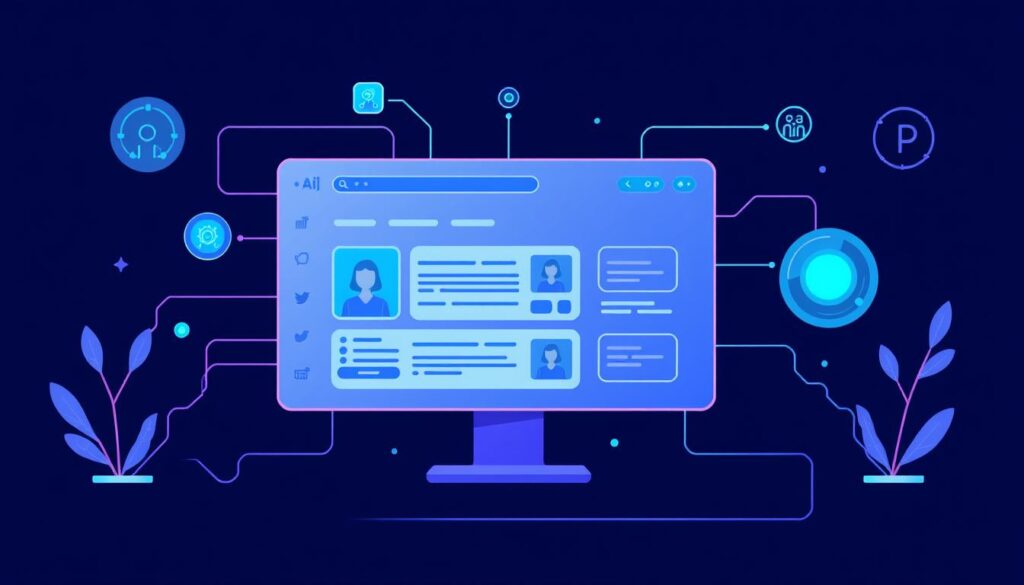
AI-enhanced content hubs deliver personalized experiences based on user behavior and preferences
In 2025, leading brands are creating dynamic content hubs that adapt to individual user preferences and behaviors. Unlike traditional blogs, these hubs use AI to analyze user data and deliver personalized content experiences.
How to implement:
- Segment your audience based on behavior, interests, and stage in the buyer journey
- Create content clusters around core topics that appeal to different segments
- Implement AI-powered recommendation engines to suggest relevant content
- Use progressive profiling to refine personalization over time
- Track engagement metrics to continuously improve the experience
This approach not only improves user experience but also increases time on site, reduces bounce rates, and signals to search engines that your content is valuable and engaging.
2. Voice Search-Optimized Content
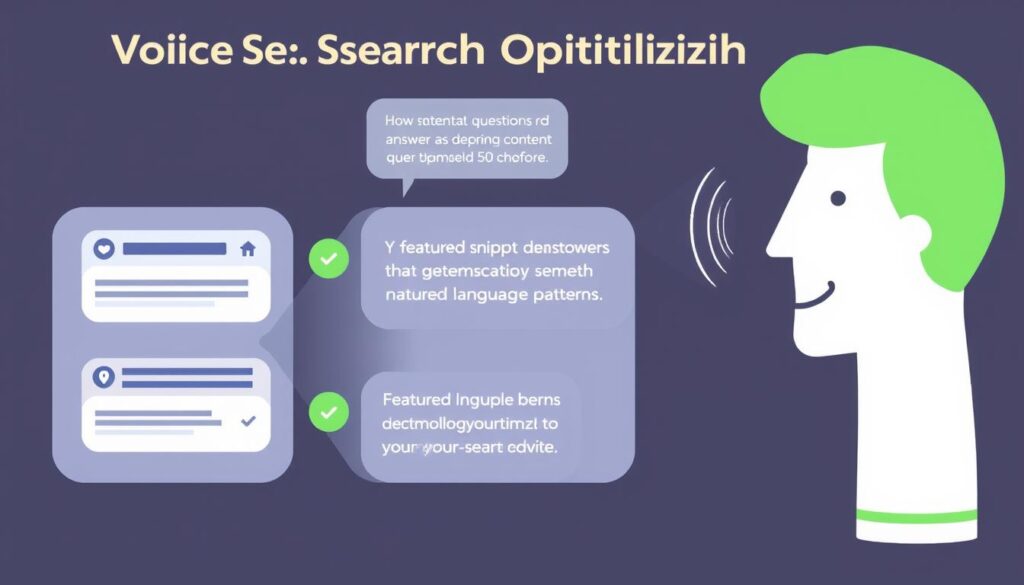
Voice search optimization requires conversational content that answers specific questions
With voice search continuing to grow in popularity, optimizing content for voice queries has become essential. Voice searches tend to be longer, more conversational, and often phrased as questions.
How to implement:
- Research conversational keywords and question-based queries
- Structure content around specific questions and provide clear, concise answers
- Use natural language and conversational tone
- Create FAQ sections that directly address common voice queries
- Optimize for featured snippets, which are often used for voice search results
Voice-optimized content not only captures traffic from voice searches but also tends to perform well in traditional search results, as it aligns with how people naturally think and ask questions.
3. Interactive Content Experiences

Interactive content like quizzes and calculators drive higher engagement and longer session times
Interactive content continues to outperform passive content in terms of engagement and sharing. In 2025, marketers are creating increasingly sophisticated interactive experiences that provide personalized value while collecting valuable data.
How to implement:
- Develop quizzes that help users identify their needs or challenges
- Create calculators that demonstrate the value of your products or services
- Build interactive infographics that allow users to explore data relevant to their interests
- Design assessments that provide personalized recommendations
- Implement configurators that help users visualize customized solutions
Interactive content not only drives higher engagement metrics (which search engines value) but also generates valuable first-party data that can inform your broader marketing strategy.
4. Multimedia Content Clusters
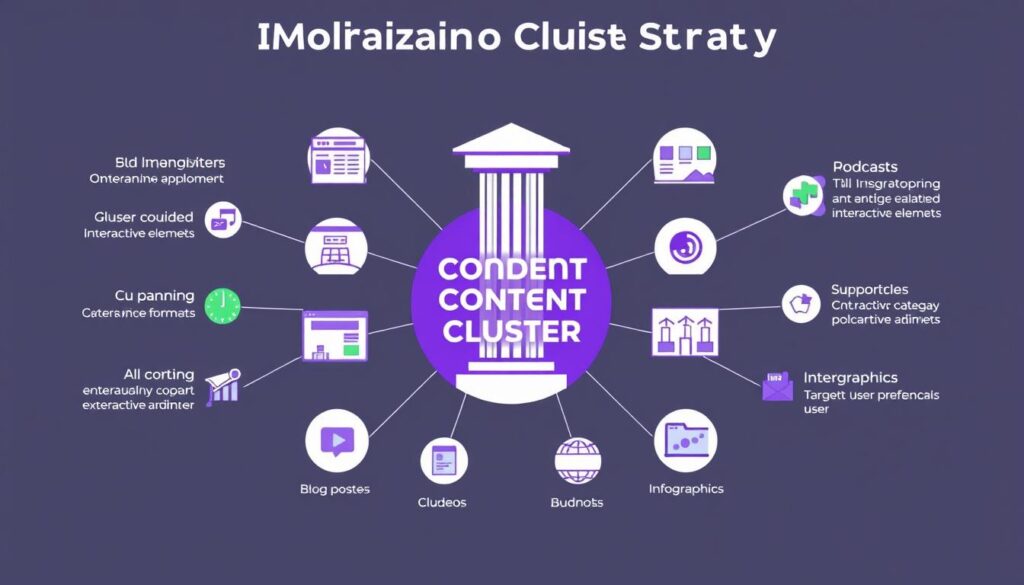
Multimedia content clusters connect related topics across different content formats
Content clusters have evolved beyond text-based articles to include multiple media formats that cater to different learning preferences and search behaviors.
How to implement:
- Identify a core topic (pillar content) and related subtopics
- Create comprehensive pillar content that provides an overview of the topic
- Develop related content in various formats (videos, podcasts, infographics)
- Implement strategic internal linking to establish topic authority
- Promote each piece across appropriate channels
This approach helps establish topical authority with search engines while providing multiple entry points for different audience segments, increasing your overall organic visibility.
5. User-Generated Content Campaigns

User-generated content campaigns leverage authentic customer experiences to build trust
User-generated content (UGC) continues to be one of the most effective ways to build trust and authenticity while expanding your content library with minimal resources.
How to implement:
- Create branded hashtags that encourage customers to share their experiences
- Develop contests or challenges that incentivize content creation
- Feature customer stories and testimonials prominently on your website
- Repurpose UGC across multiple marketing channels
- Implement a system for collecting and managing permission to use customer content
UGC not only provides social proof but also helps your content rank for long-tail keywords and natural language queries that you might not have thought to target.
6. Augmented Reality (AR) Content Experiences
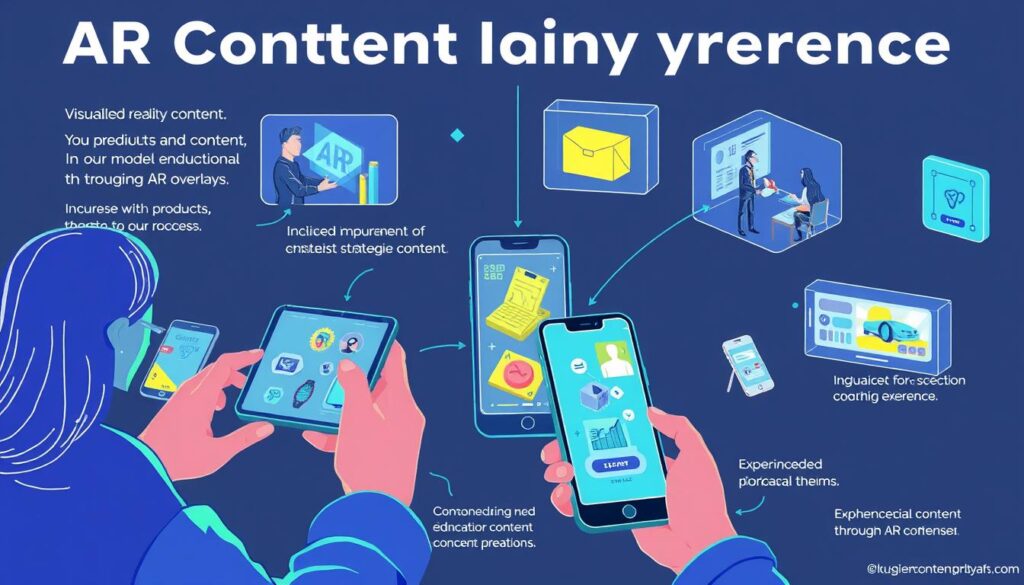
AR content experiences create memorable interactions that drive engagement and sharing
As AR technology becomes more accessible, forward-thinking brands are creating immersive content experiences that blend digital information with the physical world.
How to implement:
- Develop AR product visualizations that help customers make purchase decisions
- Create interactive AR tutorials or guides that enhance product understanding
- Build location-based AR experiences that connect digital content to physical spaces
- Design shareable AR filters or effects that promote brand awareness
- Integrate AR experiences with your website and social media content
AR content not only creates memorable experiences that users want to share but also keeps visitors engaged with your brand for longer periods, sending positive signals to search algorithms.
7. Micro-Content Ecosystems
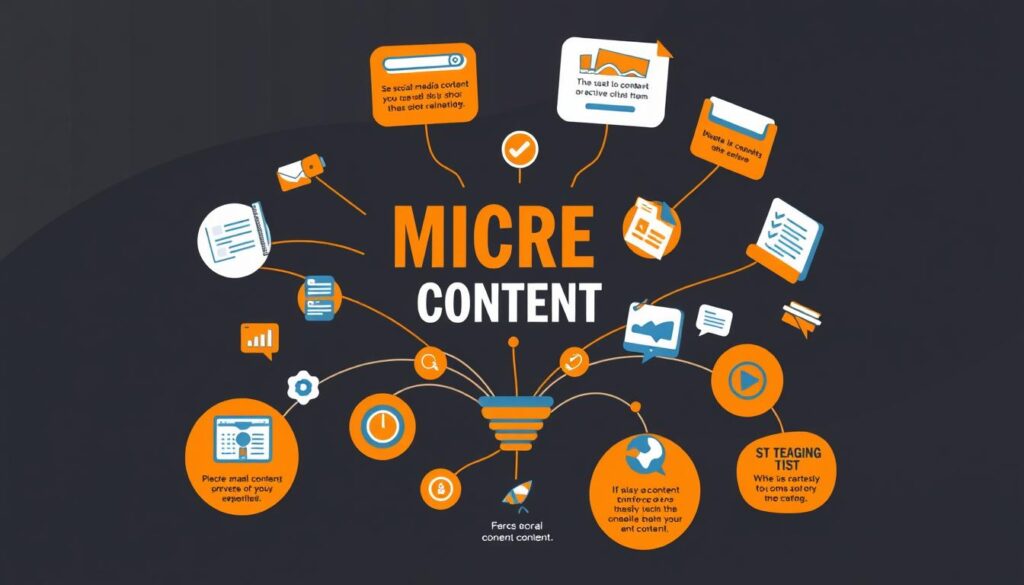
Micro-content ecosystems connect short-form content to drive traffic to comprehensive resources
With shrinking attention spans, micro-content (short, focused pieces of content) has become increasingly important for capturing initial interest and driving traffic to more comprehensive resources.
How to implement:
- Extract key insights, statistics, or quotes from longer content
- Create platform-specific micro-content (TikTok videos, Instagram Reels, Twitter threads)
- Design a strategic journey that leads from micro-content to more in-depth resources
- Use consistent branding and messaging across all micro-content
- Track which micro-content formats and topics drive the most engagement and traffic
Effective micro-content strategies capture attention in crowded feeds and create multiple entry points to your content ecosystem, increasing overall organic visibility.
8. Expert Collaboration Networks
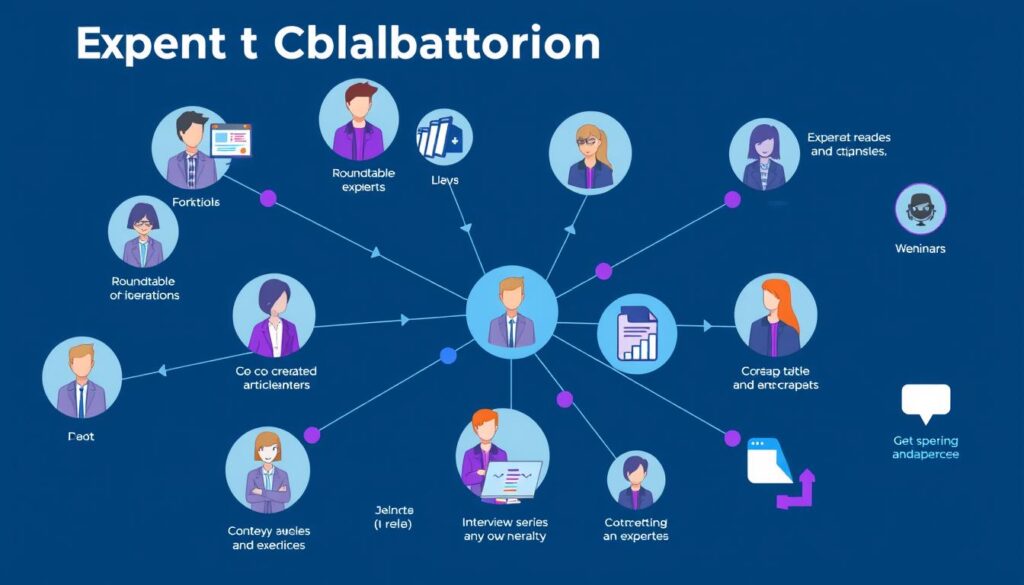
Expert collaboration networks leverage combined expertise and audiences to expand reach
Collaborative content that brings together multiple experts not only improves content quality but also expands reach through combined audiences and expertise.
How to implement:
- Identify complementary experts or brands in your industry
- Create roundtable discussions or panel webinars on trending topics
- Develop co-branded research reports or whitepapers
- Build an expert interview series that showcases diverse perspectives
- Implement cross-promotion strategies to leverage each participant’s audience
Expert collaborations signal authority to search engines while providing access to new audiences, resulting in increased organic visibility and backlink opportunities.
9. Data Storytelling and Visualization
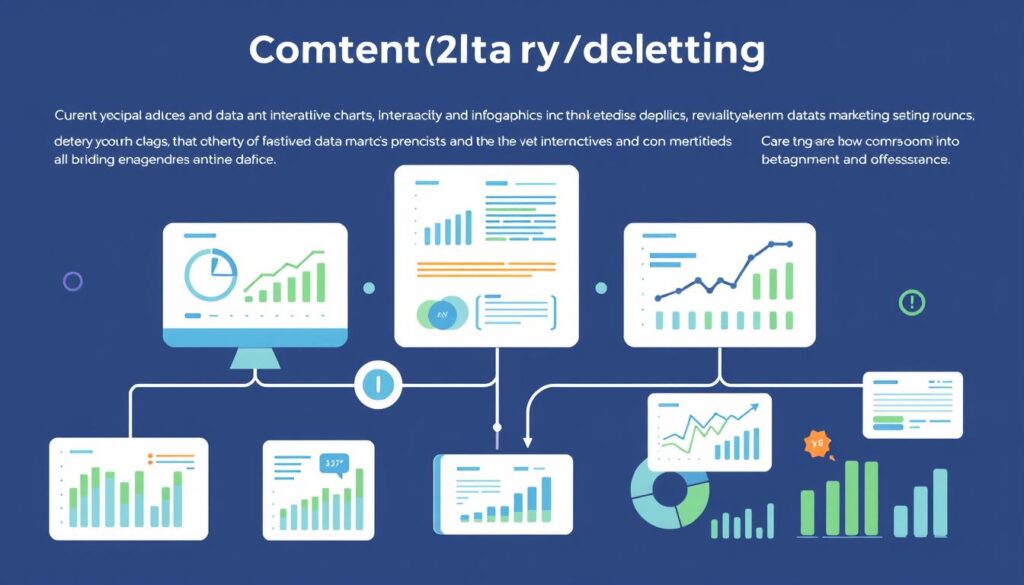
Data storytelling transforms complex information into engaging visual narratives
In an era of information overload, the ability to transform complex data into compelling visual narratives has become a powerful way to capture attention and build authority.
How to implement:
- Conduct original research or analyze existing data to uncover unique insights
- Create visually appealing charts, graphs, and infographics that simplify complex information
- Develop interactive data visualizations that allow users to explore information
- Craft narrative frameworks that put data in context and highlight key takeaways
- Promote data-driven content to industry publications and influencers
Data-driven content tends to earn more backlinks and social shares, boosting your domain authority and organic rankings while positioning your brand as a thought leader.
10. Semantic Content Optimization
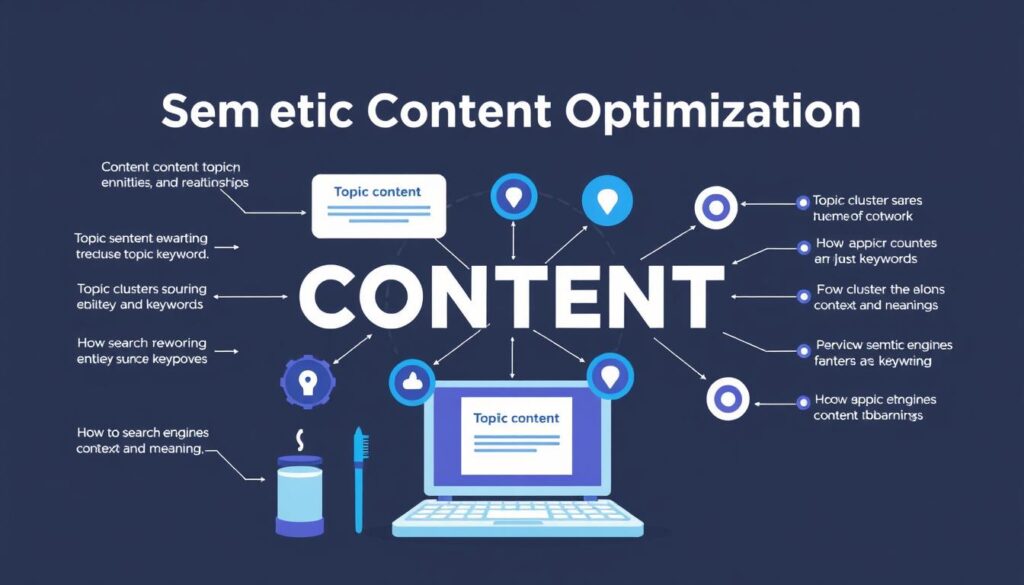
Semantic optimization focuses on topics and relationships rather than just keywords
As search engines become more sophisticated in understanding context and intent, semantic optimization has evolved beyond keywords to focus on topics, entities, and relationships.
How to implement:
- Research related concepts, entities, and questions around your target topics
- Create comprehensive content that addresses the full scope of a topic
- Use natural language that covers semantic variations rather than repeating exact keywords
- Implement structured data markup to help search engines understand your content
- Build internal linking structures that reinforce topical relationships
Semantic optimization helps your content rank for a wider range of related queries and positions your site as an authoritative resource on specific topics.
Implementing Your Content Marketing Strategy for 2025
Having great ideas is only the beginning. Successful content marketing requires thoughtful implementation and ongoing optimization. Here’s how to put these ideas into action:
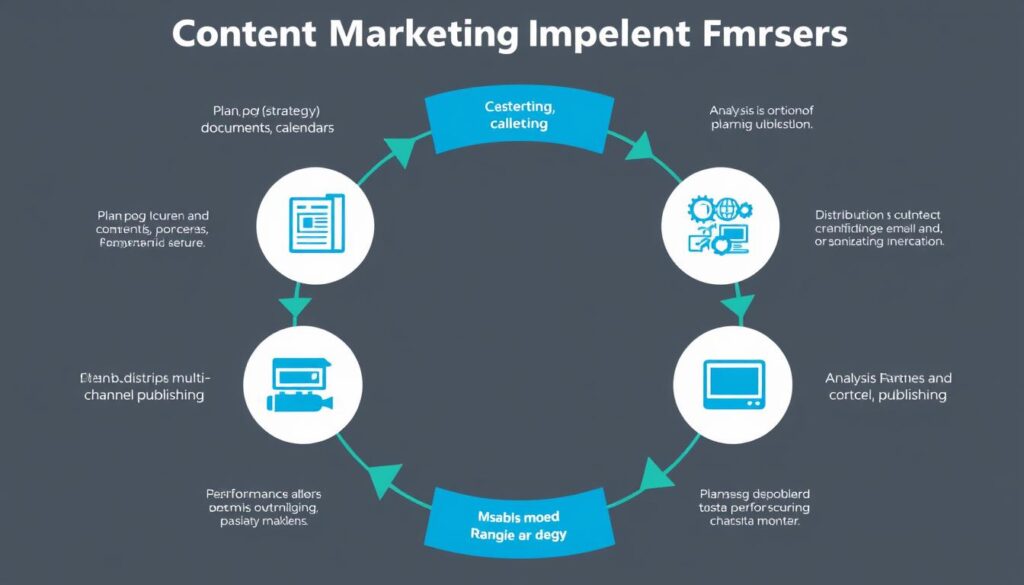
Effective implementation requires a systematic approach to planning, creation, distribution, and analysis
Start with a Strategic Audit
Before implementing new ideas, assess your current content performance. Identify what’s working, what’s not, and where the biggest opportunities lie. This baseline will help you prioritize your efforts and measure progress.
Develop a Content Calendar
Create a structured content calendar that balances different content types, topics, and formats. Align your content schedule with business goals, seasonal trends, and audience needs to maximize impact.
Build a Content Production System
Establish efficient workflows for content creation, review, and publication. Consider which elements you’ll handle in-house versus outsourcing, and develop templates and guidelines to maintain consistency.
Implement a Distribution Strategy
Develop a multi-channel distribution plan that leverages owned, earned, and shared media. Consider how each piece of content will be promoted across different platforms to reach your target audience.
Measure and Optimize
Implement tracking systems to monitor key performance indicators (KPIs) for your content. Regularly analyze results and use these insights to refine your approach and double down on what’s working.
| Content Type | Primary KPIs | Distribution Channels | Resource Requirements |
| Blog Articles | Organic traffic, Time on page, Backlinks | SEO, Social media, Email | Writer, Editor, SEO specialist |
| Video Content | Watch time, Engagement rate, Shares | YouTube, Social media, Website | Videographer, Editor, Script writer |
| Interactive Content | Completion rate, Lead generation, Time on page | Website, Email, Paid social | Designer, Developer, Content strategist |
| Podcasts | Downloads, Subscribers, Website referrals | Podcast platforms, Social media, Email | Host, Producer, Audio editor |
| Data Visualizations | Backlinks, Social shares, Media mentions | PR outreach, Social media, Industry publications | Data analyst, Designer, PR specialist |
Essential Tools for Content Marketing Success in 2025
The right tools can significantly enhance your content marketing effectiveness. Here are some essential categories of tools to consider:
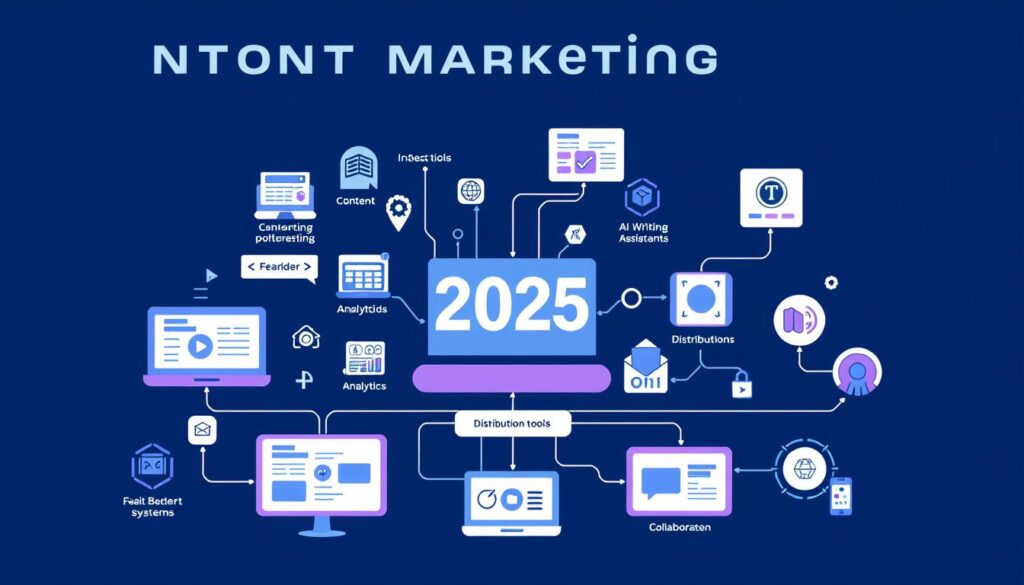
A well-integrated marketing technology stack streamlines content creation and optimization
Content Research and Planning
- SEO Research Tools: BuzzSumo, Ahrefs, Semrush
- Audience Research: SparkToro, Google Analytics, UserTesting
- Content Planning: CoSchedule, Trello, Asana
Content Creation and Optimization
- AI Writing Assistants: Jasper, ChatGPT, Copy.ai
- SEO Optimization: Clearscope, Surfer SEO, MarketMuse
- Design Tools: Canva, Adobe Creative Suite, Figma
Content Distribution and Promotion
- Social Media Management: Hootsuite, Buffer, Sprout Social
- Email Marketing: Mailchimp, ConvertKit, ActiveCampaign
- Content Syndication: Outbrain, Taboola, Medium
Analytics and Measurement
- Web Analytics: Google Analytics, Matomo, Hotjar
- Content Performance: Parse.ly, Contentsquare, Google Search Console
- Attribution Modeling: Google Attribution, Windsor.ai, Dreamdata
Case Studies: Content Marketing Success Stories
Learning from successful examples can provide valuable insights for your own content marketing strategy. Here are three case studies that demonstrate the effectiveness of the ideas we’ve discussed:
Case Study 1: B2B SaaS Company
A mid-sized SaaS company implemented a multimedia content cluster strategy focused on their core service areas. They created comprehensive pillar pages supported by blog posts, videos, and interactive tools, all internally linked to establish topical authority.
Results:
- 127% increase in organic traffic within 6 months
- 83% improvement in average session duration
- 46% increase in lead generation from organic sources
- Top 3 rankings for 18 high-value industry keywords
Key Takeaway: Comprehensive content clusters that address topics from multiple angles and in different formats can significantly improve search visibility and engagement.
Case Study 2: E-commerce Retailer
An online fashion retailer launched a user-generated content campaign that encouraged customers to share styling photos with a branded hashtag. They curated this content on product pages and in a dedicated gallery, while also creating shoppable posts on social media.
Results:
- 215% increase in social media referral traffic
- 34% higher conversion rate on product pages featuring UGC
- 68% increase in time spent on site
- 12,000+ pieces of user-generated content collected
Key Takeaway: Authentic user content creates trust and provides social proof that can significantly impact conversion rates while expanding your content library.
Case Study 3: Financial Services Provider
A financial advisory firm created an interactive content hub with personalized calculators, assessment tools, and educational resources. The hub adapted content based on user behavior and preferences, creating a tailored experience for different audience segments.
Results:
- 156% increase in lead quality
- 42% reduction in cost per acquisition
- 78% of users engaged with multiple content pieces
- 3.2x increase in return visitor rate
Key Takeaway: Personalized, interactive content that provides immediate value creates stronger engagement and higher-quality leads than static, one-size-fits-all approaches.
Frequently Asked Questions About Content Marketing in 2025
How has AI changed content marketing in 2025?
AI has transformed content marketing in several ways: it enables more sophisticated personalization, streamlines content creation and optimization, powers advanced analytics for better decision-making, and facilitates more effective content distribution. However, the most successful marketers use AI as a tool to enhance human creativity and strategic thinking, not replace it. The combination of AI efficiency with human insight and authenticity delivers the best results.
How often should I publish new content to drive organic traffic?
Quality and relevance matter more than frequency. In 2025, search engines prioritize comprehensive, valuable content that thoroughly addresses user needs. For most businesses, publishing 1-4 high-quality pieces per month is more effective than pushing out daily content of lower quality. Focus on creating content that provides unique value and keeps users engaged, then promote it effectively across multiple channels.
What content formats drive the most organic traffic in 2025?
The most effective format depends on your audience and industry, but comprehensive, multi-media content tends to perform best. This includes in-depth articles supported by videos, interactive elements, and visual content. Content that answers specific questions thoroughly, provides unique insights, and delivers exceptional user experience typically ranks highest. The key is understanding your audience’s preferences and search behaviors, then creating content that best serves their needs.
How do I measure the ROI of my content marketing efforts?
Measuring content marketing ROI requires tracking both direct and indirect contributions to business goals. Start by setting clear objectives and KPIs for each piece of content. Use attribution modeling to understand how content influences conversions across the customer journey. Track metrics like organic traffic growth, engagement rates, lead generation, and conversion rates. For a comprehensive view, also consider content’s impact on customer retention, brand awareness, and search visibility. Modern analytics platforms can help connect content performance to revenue outcomes.
How can small businesses compete with larger companies in content marketing?
Small businesses can effectively compete by focusing on niche expertise, local relevance, and authentic storytelling. Rather than trying to cover every topic, concentrate on specific areas where you can provide unique insights or solve particular problems better than larger competitors. Leverage your agility to respond quickly to industry trends and audience needs. Build relationships with your community and collaborate with complementary businesses to expand your reach. Quality, authenticity, and relevance will outperform sheer volume in driving organic traffic.
Conclusion: Building Your Content Marketing Strategy for 2025 and Beyond
As we’ve explored throughout this article, content marketing continues to be a powerful driver of organic traffic in 2025, but the landscape has evolved significantly. Success now requires a strategic approach that combines creativity, technical optimization, and audience-centricity.
The most effective content marketing strategies focus on creating exceptional value for specific audiences, leveraging emerging technologies and formats while maintaining a human touch. By implementing the ideas we’ve discussed—from personalized content hubs and interactive experiences to semantic optimization and expert collaborations—you can build a content ecosystem that attracts, engages, and converts your target audience.
Remember that content marketing is a long-term investment. While you may see some immediate results, the full benefits often take time to materialize as you build authority, trust, and visibility. Stay consistent, measure your results, and continuously refine your approach based on performance data and evolving best practices.
Ready to Transform Your Content Marketing Strategy?
Get a personalized content marketing roadmap tailored to your specific business goals and audience. Our expert team will analyze your current performance and develop a strategic plan to drive sustainable organic traffic growth in 2025.
By staying informed about emerging trends and continuously adapting your approach, you can ensure that your content marketing efforts continue to drive valuable organic traffic and business results well into the future.


